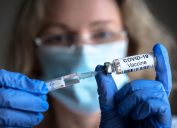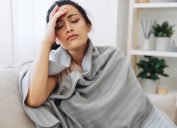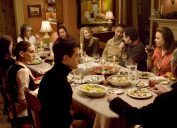The Most Accurate Time to Take a COVID Test, New Study Reveals
You might want to wait a few days if you're feeling under the weather.
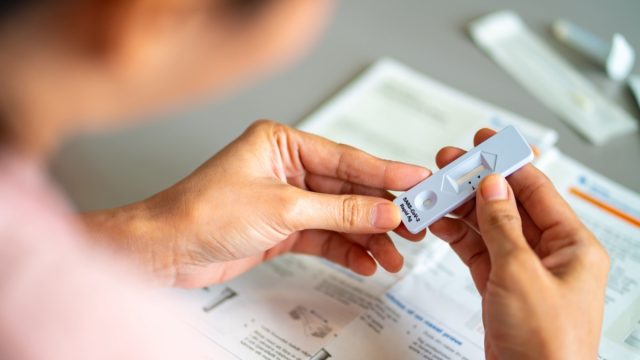
Testing for COVID has, thankfully, never been easier. Instead of having to venture to urgent care or the emergency room—like we had to at the beginning of the pandemic—cases can now be diagnosed at home with kits you pick up at your local drugstore. It's common to keep a few of these tests on hand in the event you or a family member starts to feel sick. But if you get the sniffles or a minor fever, you might not want to reach for a test right away, according to data from a new study. Read on to find out when researchers say is the most accurate time to take a COVID test.
RELATED: 10 Places Bringing Back Mask Mandates Right Now.
You should wait a bit to test, experts say.

In a Sept. 28 study published in Clinical Infectious Diseases, researchers studied 350 people to determine when at-home COVID tests are the most accurate. Most participants (91.1 percent) had a history or vaccination or had previously been infected with COVID-19.
According to findings, "viral load" peaked on the fourth day that patients showed symptoms, meaning that's the ideal day to test.
"Viral load just refers to the amount of virus that is replicating in your body, so the more virus that is replicating, the more chance of a test turning positive," John Brownstein, PhD, chief innovation officer at Boston Children's Hospital and contributor for ABC News, told the outlet. "Right at the beginning point of an infection, there's limited viral copies. But as the infection progresses, you'll have an increasing amount of virus replicating in your body."
RELATED: COVID Symptoms Now Follow a Distinct Pattern, Doctors Report.
You can't rule out COVID if you test on day one or two.
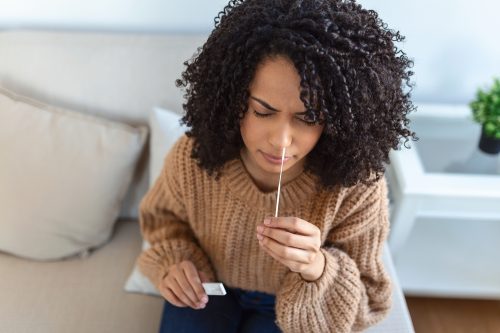
According to the study, there was still a chance of accurate results on the third day of symptoms, although patients were more likely to test negative.
If you test on the first or second day you don't feel well, results are even less reliable, the study suggests.
"Individuals who test negative on antigen tests on the first or second day of symptoms—or even on the third—and who
remain symptomatic need to clearly understand that COVID has not been excluded," the study reads.
RELATED: Some Major Pharmacies Are Charging $190 for New COVID Shot—Here's Why.
These results differ from what experts found in the past.

According to researchers, the results are "very different" from what data was showing at the beginning of the pandemic, when viral loads were highest when symptoms started and declined from that point on. They explained that their results suggest viral loads and symptom duration are both subject to change with COVID, meaning that data from early in the pandemic might not still apply now or in the future.
These findings also aren't perfectly aligned with the current Centers for Disease Control and Prevention (CDC) guidelines, which instruct people to "test immediately" when symptoms appear. However, the agency does note that PCR tests are more reliable, and if your antigen test is negative, that result isn't always accurate. In the event your antigen test is negative, the CDC recommends taking another one 48 hours later, or going to get a PCR test.
But while you may want to wait until day four to test for COVID, the same can't be said of the flu. When looking at the flu virus, researchers found that day two was the most accurate when testing, because that was when viral loads peaked.
Doctors recently reported that COVID symptoms have changed.
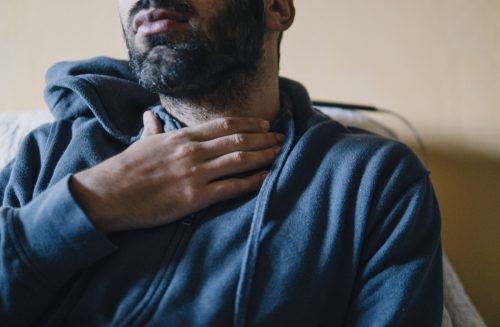
In addition to news about testing, last month, doctors told NBC News that COVID is now following a different pattern, and mainly affecting the upper respiratory tract. Your first sign of COVID is likely to be a sore throat, which will clear up as congestion sets in, along with other potential symptoms like fatigue, aches, fever, chills, headache, and post-nasal drip.
A dry cough, as well as loss of taste and smell—all of which used to be fairly clear signs of COVID—are now less common. As Grace McComsey, MD, vice dean for clinical and translational research at Case Western University, told NBC News, only about 10 to 20 percent of her COVID patients are reporting loss of smell or taste. In the past, these numbers were around 60 to 70 percent.
"It isn't the same typical symptoms that we were seeing before. It's a lot of congestion, sometimes sneezing, usually a mild sore throat," Erick Eiting, MD, vice chair of operations for emergency medicine at Mount Sinai Downtown in New York, told the outlet, noting that diarrhea has also become less common among COVID patients.
RELATED: For more up-to-date information, sign up for our daily newsletter.

